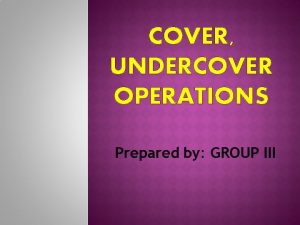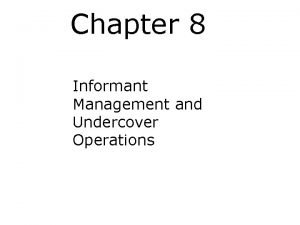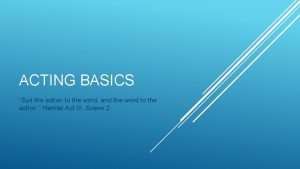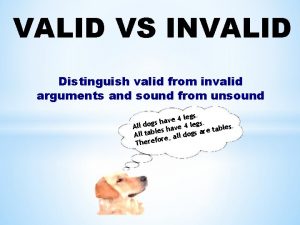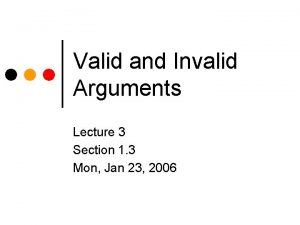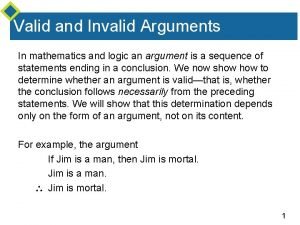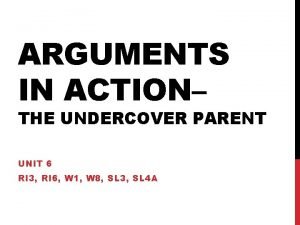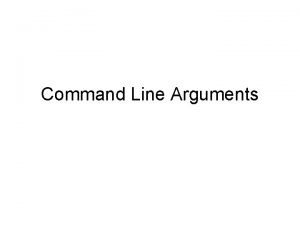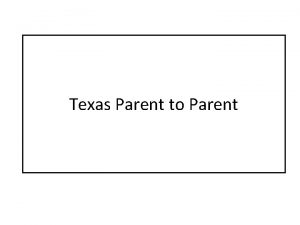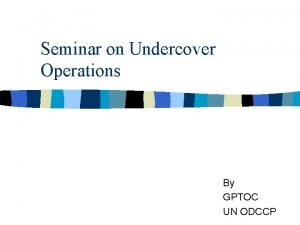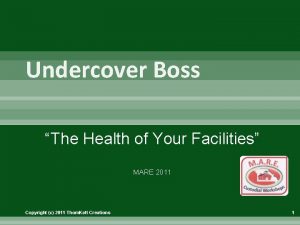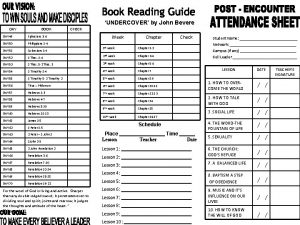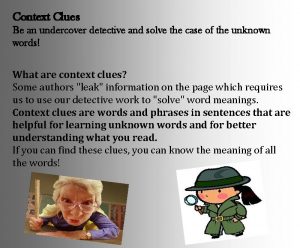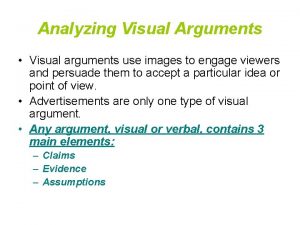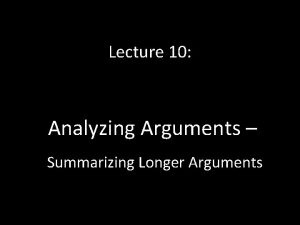ARGUMENTS IN ACTION THE UNDERCOVER PARENT UNIT 6
























































- Slides: 56

ARGUMENTS IN ACTION– THE UNDERCOVER PARENT UNIT 6 RI 3, RI 6, W 1, W 8, SL 3, SL 4 A

CLOSE READING SOAPSTONE & RHETORICAL PRÉCIS TASK 1

TRANSITION JOURNAL Romeo and Juliet keep their love and relationship a complete secret (except for a couple trusted individuals), and it ends in complete disaster, violence, and tragedy. How would the story play out differently if Romeo and Juliet were teenagers in modern society who communicated electronically (e. g. , social media, email, private messages, etc. ), and their respective parents had spyware to track and monitor their correspondence?

1. ANTICIPATION GUIDE I will give you 8 different statements. PART 1: 1. Copy down each statement. Leave 4 lines between each statement 2. Decide if you agree or disagree with the statement • A for Agree • D for Disagree • SA for Strongly Agree • SD for Strongly Disagree. 3. Then write one sentence explaining your position

Your Opinion: Parent’s Perspective: • • A for Agree D for Disagree SA for Strongly Agree SD for Strongly Disagree. ____/____ 1. When I become a parent, I will spy on my teenaged son or daughter to find out what he or she is doing. LEAVE 4 LINES IN BETWEEN EACH SENTENCE: Write one sentence of explanation ____ /____ 2. The Internet can be a dangerous place. ____ /____ 3. I know of friends who have chatted online with people they don’t really know. ____/____ 4. Cyber-bullying takes place on social networking sites (i. e. , Facebook, Instagram, etc. ) among my friends. ____/____ 5. If you’re old enough to go on the Internet, you’re old enough to know the dangers. ____/____ 6. Parents should monitor some of their teens’ Internet use. ____/____ 7. Teens’ social networking profiles should be set at the highest privacy settings. ____ /____ 8. Teens have a right to privacy.

#1 Anticipation Guide PART 2: PARENT’S PERSPECTIVE Now imagine that you are a parent of teenagers rather than a teenager yourself. Respond to the same eight statements from a parent’s perspective and react as you think a parent might react. 1. Decide if you agree or disagree with the statement • A for Agree • D for Disagree • SA for Strongly Agree • SD for Strongly Disagree. 2. Then write one sentence explaining your position from the perspective of a parent

#2 CONNOTATION – WORD STUDY With a partner, discuss what the concept of “privacy” means to you. Together try and define privacy. Then copy down the correct definition… privacy (n. ): the state or condition of being free from being observed or disturbed by other people.

#2 CONNOTATION – WORD STUDY Order the words by their positive to negative connotation Be prepared to defend your choices after you and your partner have completed your chart. “Connotation” means the emotional feeling or cultural association a word evokes in addition to its dictionary definition. • • • surveillance monitor protective negligence invasion of privacy eavesdrop overprotective independence parental responsibility • guard • nosy • watchful Most Positive Most Negative

#3 METHODS OF PERSUASION NOTES • Rhetoric is the art of persuasion. • The goal of persuasion is to change others’ point of view or to move others to take action. • There are three methods of persuasion:

LOGOS = LOGIC / REASON Logos is an argument based on facts, evidence and reason. Using logos means appealing to the readers’ sense of what is logical.

ETHOS = ETHICS / IMAGE Ethos is an argument based on character. The writer or speaker presents him or herself to the reader as credible, trustworthy, honest, and ethical.

PATHOS = PASSION / EMOTIONS Pathos is an argument based on feelings Using pathos means appealing to readers’ emotions and feelings (ex. fear, sympathy, love, pride, etc. )

#4 CLOSE READING NOTES • Annotation Symbols • Annotation Colors • 1 st Read and Discussion – Key Ideas and Details • 2 nd Read and Discussion – Craft and Structure • 3 rd Read and Discussion – Author’s Argument

ANNOTATION SYMBOLS Symbol Comments/Questions/Resp onse ? • Questions I have • Confusing parts for me + * ! • Ideas/statements I agree with ο • Ideas/sections you connect with • What this reminds you of • Ideas/statements I disagree with • Significant Ideas • Shocking statements or parts • Emotional parts

ANNOTATION COLORS Color Device Yellow Vocabulary Words Pink Language (ex. analogy, allusions, repetition, parallelism, personal anecdote, hyperbole, appositives, connotation, root words, etc. ) Blue Logos Green Ethos Purple Pathos

1 ST READ Read for Key Ideas and Details • What does the article explicitly say about the topic? • What is the central/main idea of the article? • How does the author unfold the main idea throughout the article?

1 ST DISCUSSION • With a partner discuss the Key Ideas and Details you found: –What does the article explicitly say about the topic? –What is the central/main idea of the article? –How does the author unfold the main idea throughout the article? *After, we will discuss as a class

2 ND READ Read for Craft and Structure • What words and phrases are used to shape the author’s tone? • How is the article structured? Is it effective? • What is the author’s point of view?

2 ND DISCUSSION • With a partner discuss the examples of Craft and Structure you found: –What words and phrases are used to shape the author’s tone? –How is the article structured? Is it effective? –What is the author’s point of view? *After, we will discuss as a class

3 RD READ • Read for author’s argument –How does the author develop his/her argument? –What rhetorical techniques does the author use to advance his/her argument? • Logos • Ethos • Pathos –How does this author’s argument compare to the other arguments we have read? –What are some additional counterclaims to this author’s argument that you can brainstorm?

3 RD DISCUSSION • With a partner discuss the examples you found that support the author’s argument: –How does the author develop his/her argument? –What rhetorical techniques does the author use to advance his/her argument? • Logos • Ethos • Pathos –How does this author’s argument compare to the other arguments we have read? –What are some additional counterclaims to this author’s argument that you can brainstorm?

UNDERCOVER PARENT – 1 ST READ (KEY IDEAS AND DETAILS) For each chunk of paragraphs summarize what Coben is trying to do. By annotating your article in the margin. Example: Paragraphs 1 -3: Coben introduces the concept of…monitoring your children by installing spyware on your computer to guard children against internet dangers Your Turn: Paragraphs 4 -5: Coben acknowledges… Paragraphs 6 -10: Coben lists the rebuttals that… Paragraphs 11 -13: Coben argues that… Paragraphs 14 -15: Coben concedes…

UNDERCOVER PARENT – 2 ND READ (CRAFT AND STRUCTURE) 1. Why does Coben repeatedly use the word “monitor” to describe the use of spyware? What are the connotations of the word “monitor”? 2. Why does Coben also use words like “invasion of privacy, ” “eavesdropping, ” and “surveillance” to describe parents’ electronic monitoring practices? Can you find examples of other words with negative connotations that Coben uses to describe the use of spyware? How do these words impact the writer’s tone? 3. Why does Coben use the term “negligence” to describe parents who don’t monitor Internet use at all? 4. Why does Coben use words like “all, ” “everything, ” and “entire” to describe electronic monitoring and online activity? How do these word choices characterize the scope of the problem?

UNDERCOVER PARENT – 3 RD READ (AUTHOR’S ARGUMENT) Logic (Logos) 1. What kind of evidence does Coben use to support his claim? 2. What well-known cases of Internet danger does Coben cite? Do these effectively support his claim? 3. Coben addresses possible counterarguments throughout his essay. What are they? Which one is most effective?

UNDERCOVER PARENT – 3 RD READ The Writer (Ethos) 1. What does the author reveal about his background in the first paragraph, “Friends of mine confessed over dinner that they had put spyware on their 15 year-old son’s computer”? 2. Does the author seem knowledgeable about relationships between parents and their teen(s)? 3. Coben closes with an anecdote about “one friend of mine. . . ” who discovered his daughter using drugs and sleeping with her dealer. Does this anecdote add credible evidence to Coben’s research? Is it convincing?

UNDERCOVER PARENT – 3 RD READ Emotions (Pathos) 1. Does Coben’s piece affect your concern over the dangers on the Internet? 2. Does the piece scare you about the possibility of your parents “spying” on you? 3. Some examples Coben uses (drug use and sleeping with the drug dealer, cyber-bullying and suicide, and chatting with pedophiles) are extreme cases of Internet danger. Other examples—online gambling, dangerous chatter, or watching prohibited videos—are less extreme. Which examples elicit a more emotional response? Why?

#5 & #6 We just finished close reading “The Undercover Parent” and now we will complete #5 SOAPSTone chart and #6 Rhetorical Précis. Once you have completed “The Undercover Parent” activities, you will complete the same process with the following articles: • “Big Brother meets Big Mother” • “Brutally Honest” • “Child Watch” • “Is There an Ethical Problem with Child GPS Tracking? • “Should You Spy on Your Child’s Cell Phone Use?

#5 SOAPSTONE CHARTS TITLE: “The Undercover Parent” SOAPSTone - TITLE: “Child Watch” SOAPSTone - TITLE: “Big Brother meets Big Mother” SOAPSTone - TITLE: “Child GPS Tracking” SOAPSTone - TITLE: ”Brutally Honest” SOAPSTone - TITLE: “Should You Spy” SOAPSTone -

#5 SOAPSTONE • What is the Subject? The general topic, content, and ideas contained in the text • What is the Occasion? The time and place of the piece, the current situation or issue • Who is the Audience? The group of readers to whom this piece is directed • What is the Purpose? The author’s reason behind the text • Who is the Speaker? The speaker and who they are based on textual references • What is the overall Tone of the piece? How do style and word choice create fit the piece

#5 SOAPSTONE Subject, Occasion, Audience, Purpose, Speaker, Tone Complete the following sentence starters for each article: S: The article is mainly about. . . O: The events which led up to the writing of this piece include. . . A: From the words _____ and _______, it can be assumed that the author’s intended audience is. . . P: The main purpose of this article is to. . . S: From the words ______ and _______, it can be assumed that the author (is). . . Tone: From the words ______ and _______, it can be assumed that the author is trying to create a _______ tone.

#6 RHETORICAL PRÉCIS Write a rhetorical pre cis (one paragraph) of the article. A pre cis is a concise summary of what you’ve read, including both what the text says and what the text does rhetorically. In other words, a pre cis presents the what, how, why, and who of a writer’s argument. Use the pre cis template below, as well as the directions provided for you Sentence 1: Name of the author, genre, and title of work, date in parentheses; a rhetorically accurate verb (such as “claims, ” “argues, ” “asserts, ” “suggests”); and a “that” clause containing the major assertion or thesis statement in the work. Sentence 2: An explanation of how the author develops and supports thesis, usually in chronological order. Sentence 3: A statement of the author’s apparent purpose, followed by an “in order to” phrase. Sentence 4: A description of the intended audience and/or the relationship the author establishes with the audience.

WEAK PRÉCIS In the “The Undercover Parent” (2008), Harlan Coben asserts that parents should discuss installing spyware on their children’s computers so they can be monitored. Coben backs up this claim by using different situations that are possible and by acknowledging both sides of the argument. Coben encourages parents to install the spyware in order to keep teens safe. Coben writes to parents of teens and teenagers themselves as a mediator with a concerned tone.

MEDIOCRE PRÉCIS In the op-ed editorial “The Undercover Parent” (2008), Harlan Coben debates whether or not parents should use spyware to monitor and protect their children on the Internet. Coben cites life examples, and rebuts possible objections, while sharing the dangers he’s learned in his research to establish understanding with parents who waver over the decision to use spyware. In a concerned and informative tone, Coben ultimately suggests setting the spyware aside and opening a dialogue with teens to discuss the dangers of the Internet.

STRONG PRÉCIS… Harlan Coben’s op-ed piece, “The Undercover Parent” (2008) argues that using spyware to monitor children’s online activity is an unpleasant but probably necessary part of responsible parenting in today’s world. Coben approaches this uncomfortable subject with a blunt tone and numerous concessions and anecdotes that candidly acknowledge both the dangers of the Internet and the distastefulness of electronic monitoring. His apparent purpose is to alert parents to the potential dangers of the Internet and increase parental involvement and protection in children’s online lives. While Coben does not explicitly identify himself as a parent, he does present himself as a peer of parents of teenagers, and his audience is clearly parents whose children have home access to the Internet.

#6 RHETORICAL PRÉCIS COMPLETE A PRÉCIS FOR EACH ARTICLE Sentence 1: Name of the author, genre, and title of work, date in parentheses; a rhetorically accurate verb (such as “claims, ” “argues, ” “asserts, ” “suggests”); and a “that” clause containing the major assertion or thesis statement in the work. Sentence 2: An explanation of how the author develops and supports thesis, usually in chronological order. Sentence 3: A statement of the author’s apparent purpose, followed by an “in order to” phrase. Sentence 4: A description of the intended audience and/or the relationship the author establishes with the audience.


PHILOSOPHICAL CHAIRS TASK 2

#7 PHILOSOPHICAL CHAIRS Before: 1. Copy down the statement 2. Explain if your answer is Yes/No/Undecided and why? During 3. How many times do you speak? 4. How many times do you move sides? After 5. Explain why your position strengthened, weakened, or changed, and the reasons for your thinking. 6. What was the most frustrating part of today’s discussion? 7. What was the most successful part? 8. What statements led you to change your seat or to remain sitting in your original position? 9. What conclusions can you draw about how you form your beliefs based on today’s discussion? 10. What would you change about your participation in today’s activity? Do you wish you had said something that you did not? Did you think about changing seats but didn’t? Explain.

PHILOSOPHICAL CHAIRS RULES OF ENGAGEMENT 1. 2. 3. 4. 5. 6. 7. 8. Be sure you understand the central statement or topic before the discussion begins. Decide which section you will sit in. Listen carefully when others speak and seek to understand their arguments even if you don’t agree. Wait for the mediator to recognize you before you speak; only one person speaks at a time. You must first summarize briefly the previous speaker’s argument before you make your response. If you have spoken for your side, you must wait until three other people on your side speak before you speak again. Be sure that when you speak, you address the ideas, not the person stating them. Keep an open mind and move to the other side or the undecided section if you feel that someone made a good argument or your opinion is swayed. Support the mediator by maintaining order and helping the discussion to progress.

TOPIC: PARENTAL MONITORING… Invasion of privacy or parental responsibility?

ARGUMENT ESSAY INVASION OF PRIVACY VS. PARENTAL RESPONSIBILITY? TASK 3

#8 Essay Writing ARGUMENT ESSAY PROMPT After completing all of the readings, take a stance on the issue of parental monitoring. Support your position by providing reasons and examples from the readings or your own research. Incorporate rhetorical strategies to strengthen your argument.

GATHERING EVIDENCE TO SUPPORT YOUR CLAIM • Choose evidence that supports your thesis statement. • Evidence is probably the most important factor in writing an argument essay. • Without solid evidence, your essay is nothing more than opinion; with it, your essay can be powerful and persuasive. • If you supply convincing evidence, your readers will not only understand your position but may also agree with it. • Evidence can consist of facts, reasons, incidents, examples, details, and statistics.

ANTICIPATE OPPOSING POINTS OF VIEW COUNTERCLAIM • In addition to stating and supporting your position, anticipating and responding to opposing views are important. • Presenting only your side of the argument leaves half the story untold—the opposition’s half. • If you acknowledge that there are opposing arguments and answer them, your argument is stronger.

MAINTAIN A REASONABLE TONE • Just as you probably wouldn’t win an argument by shouting or making mean or nasty comments, don’t expect your readers to respond well to such tactics. • Keep the “voice” of your essay calm and sensible. • Your readers will be much more open to what you have to say if they think you are a reasonable person. • Eliminate some person pronouns to remain objective (Ex. You, your, us, we, I, etc. )

DRAFT YOUR THESIS STATEMENT Decide your stance on parental monitoring and write your claim. Include: • • 2 points to support your claim 1 counterclaim/opposing view point FOR parental monitoring: Although privacy is important, parents should monitor their teenagers’ internet usage in order to teach their them about internet responsibility and protect them from harm. AGAINST parental monitoring: Even though it is frightening to parents to not know what their adolescent is doing online, parents should not monitor their child’s Internet usage because it is an invasion of privacy.

THESIS STATEMENT IS AN OPINION/ARGUMENT To write a thesis statement for an argument essay, you must take a stand for or against an action or an idea. In other words, your thesis statement should be debatable—a statement that can be argued or challenged and will not be met with agreement by everyone who reads it. Not debatable: Spyware can be used as a parental monitoring device that records everything a teen does online.

INTRODUCTION • Hook • Background information that the audience may need • Introduction and summary of the issue of Internet safety, parental monitoring, growing danger of the internet, etc. • Your thesis statement/claim/argument

BODY PARAGRAPHS • 2 supporting/main points to your claim • TS – Introduce main point supporting claim • CD – FRIEDS to support main point • CM – Analysis of Concrete Detail • CS – Conclusion of main point in relation to your claim • Counterargument • Counterclaim • Rebuttal (Follow Proper Paragraph Form) * FRIEDS = Facts, Reasons, Incidents, Examples, Details, Statistics)

CONCLUSION • Restatement of your claim • Summary of your main points • “So what” factor; why does this topic matter to the reader or to your audience? • Call for action or agreement

SAMPLE OUTLINE Introduction • Hook to introduce the topic to the reader (ex. Something about…spyware, internet, social media, short anecdote, etc. ) • Background information that the audience may need about the internet or spyware • Summarize the issue: explain popular arguments for and against spyware • What your argument about spyware is…your THESIS Body Paragraphs • Body Paragraph 1: One reason to support your THESIS • • TS: Introduce the main idea of the paragraph 2 CD: Evidence, experience, observations, readings that support THESIS 4 CM: Your analysis or interpretation of the concrete detail CS: Conclude the main idea of the paragraph • • Body Paragraph 2: Another reason to support your THESIS Body Paragraph 3: Include a response to an opposing point of view, then refute the opposing view’s position or show your position is better (counterargument) Conclusion • • Restate your argument Summary of main points So what factor—a new point of view or a concise statement that reinforces your position Call for action or agreement (in order to persuade!)

BE WATCHFUL OF… - No personal pronouns: you, we, I, and us. Instead use: one, his, her, reader, parent, teen, and adolescent. - Don’t do not use contractions - Said is dead (use rhetorically accurate verbs…claimed, argued, supports, suggests, adds, asserts, etc. ) - Commentary is not summary of someone else’s ideas…commentary is your analysis on their ideas - “Article Titles” are always in quotations Newspaper Names are always in italics if typed and underlined if handwritten - ALWAYS introduce your quotations!!! - In response to parents that believe spyware is an invasion of privacy, Coben suggests to “have a discussion about [their] concerns and let [their teens] know the possibility [of spyware] is there” (Coben 2). - MLA format should be FLAWLESS now. Check header, quotation integration, double spaced, times new roman, 12 pt font. 1 inch margins, works cited.

MLA WORKS CITED Structure: Last name, First name. "Article Title. " Website Title. Publisher of Website, Day Month Year article was published. Web. Day Month Year article was accessed. <URL>. Example: Cain, Kevin. "The Negative Effects of Facebook on Communication. " Social Media Today RSS. N. p. , 29 June 2012. Web. 2 Jan. 2013. Hints: • Only include URL if the source cannot be found easily • n. p. if publisher cannot be found • N. d. if published date cannot be found

PEER EDITING (EVERY PAPER YOU PEER EDIT, WRITE YOUR NAME) 1 st read: Read your own paper entirely and give a rubric score Pass paper 2 nd read: Read with pen in hand to edit for grammar and mechanics 3 rd read: Highlight BODY PARAGRAPHS - TS and CS, CD, CM Pass paper 4 th read: Read while going through checklist

CHECKLIST: - No personal pronouns: you, we, I, our, and us. - Don’t do not use contractions - Said is dead (so is saying and says) - Commentary is not summary of someone else’s ideas…commentary is your analysis on their ideas - Each body paragraph has a TS and CS - “Article Titles” are always in quotations Newspaper/Magazine Names are always in italics - ALWAYS introduce your quotations with context in this format: - In response to parents that believe spyware is an invasion of privacy, Coben suggests to “have a discussion about [their] concerns” (Coben 2). - Check header, double spaced, times new roman, 12 pt font, 1 inch margins, works cited (also double spaced): Last name, First name. "Article Title. " Website Title. Publisher of Website, Day Month Year article was published. Web. Day Month Year article was accessed. <URL>.

UNIT 6 REFLECTION 1. What did you like about the unit and would want to do again? 2. What would you have changed about this unit or how would you improve this unit if we had to do it over again? 3. What is the most memorable or interesting thing you have learned this unit? 4. What advice would you give to a freshman next year?
 The undercover parent
The undercover parent Under cover operation
Under cover operation Elements of undercover operation
Elements of undercover operation Unit 6 review questions
Unit 6 review questions Hình ảnh bộ gõ cơ thể búng tay
Hình ảnh bộ gõ cơ thể búng tay Ng-html
Ng-html Bổ thể
Bổ thể Tỉ lệ cơ thể trẻ em
Tỉ lệ cơ thể trẻ em Voi kéo gỗ như thế nào
Voi kéo gỗ như thế nào Thang điểm glasgow
Thang điểm glasgow Hát lên người ơi
Hát lên người ơi Các môn thể thao bắt đầu bằng từ đua
Các môn thể thao bắt đầu bằng từ đua Thế nào là hệ số cao nhất
Thế nào là hệ số cao nhất Các châu lục và đại dương trên thế giới
Các châu lục và đại dương trên thế giới Công thức tính độ biến thiên đông lượng
Công thức tính độ biến thiên đông lượng Trời xanh đây là của chúng ta thể thơ
Trời xanh đây là của chúng ta thể thơ Mật thư tọa độ 5x5
Mật thư tọa độ 5x5 Phép trừ bù
Phép trừ bù Phản ứng thế ankan
Phản ứng thế ankan Các châu lục và đại dương trên thế giới
Các châu lục và đại dương trên thế giới Thể thơ truyền thống
Thể thơ truyền thống Quá trình desamine hóa có thể tạo ra
Quá trình desamine hóa có thể tạo ra Một số thể thơ truyền thống
Một số thể thơ truyền thống Cái miệng bé xinh thế chỉ nói điều hay thôi
Cái miệng bé xinh thế chỉ nói điều hay thôi Vẽ hình chiếu vuông góc của vật thể sau
Vẽ hình chiếu vuông góc của vật thể sau Biện pháp chống mỏi cơ
Biện pháp chống mỏi cơ đặc điểm cơ thể của người tối cổ
đặc điểm cơ thể của người tối cổ Thế nào là giọng cùng tên?
Thế nào là giọng cùng tên? Vẽ hình chiếu đứng bằng cạnh của vật thể
Vẽ hình chiếu đứng bằng cạnh của vật thể Vẽ hình chiếu vuông góc của vật thể sau
Vẽ hình chiếu vuông góc của vật thể sau Thẻ vin
Thẻ vin đại từ thay thế
đại từ thay thế điện thế nghỉ
điện thế nghỉ Tư thế ngồi viết
Tư thế ngồi viết Diễn thế sinh thái là
Diễn thế sinh thái là Dạng đột biến một nhiễm là
Dạng đột biến một nhiễm là Các số nguyên tố
Các số nguyên tố Tư thế ngồi viết
Tư thế ngồi viết Lời thề hippocrates
Lời thề hippocrates Thiếu nhi thế giới liên hoan
Thiếu nhi thế giới liên hoan ưu thế lai là gì
ưu thế lai là gì Hươu thường đẻ mỗi lứa mấy con
Hươu thường đẻ mỗi lứa mấy con Sự nuôi và dạy con của hươu
Sự nuôi và dạy con của hươu Hệ hô hấp
Hệ hô hấp Từ ngữ thể hiện lòng nhân hậu
Từ ngữ thể hiện lòng nhân hậu Thế nào là mạng điện lắp đặt kiểu nổi
Thế nào là mạng điện lắp đặt kiểu nổi Flash forward plot structure
Flash forward plot structure The lion and the mouse plot diagram
The lion and the mouse plot diagram Stages of the plot
Stages of the plot Short story with exposition
Short story with exposition Suit the action to the word the word to the action meaning
Suit the action to the word the word to the action meaning What is at the root of most arguments and many fights?
What is at the root of most arguments and many fights? Difference between emotivism and prescriptivism
Difference between emotivism and prescriptivism Valid vs invalid arguments
Valid vs invalid arguments Propositional logic
Propositional logic Invalid argument
Invalid argument Argument and validity in mathematics
Argument and validity in mathematics

